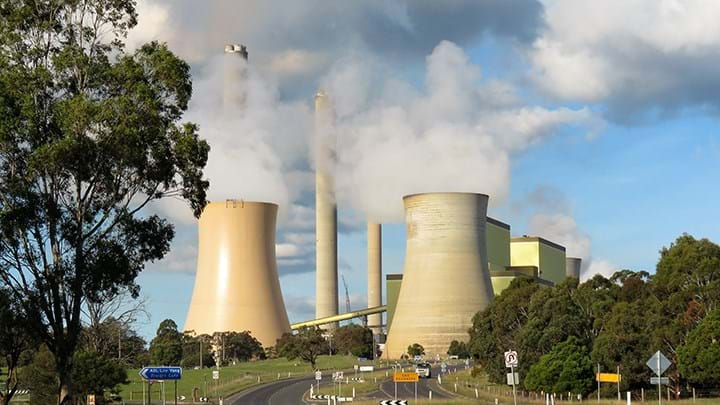Australian coal-plant closures spark energy security concerns

AUSTRALIAN energy providers AGL and Origin Energy have announced the early closures of coal-fired power stations, including the nation’s largest power station, as focus on clean generation increases and economic pressure mounts.
Government and workers have expressed concern over the impact on energy security and jobs. Clean energy proponents are cautiously welcoming the news, while environmentalists have discounted the claimed environmental benefits.
Origin submitted notice of potential early closure of its 2,880 MW Eraring power plant, Australia’s largest power plant, at the end of the required three-and-a-half-year notice period. It would close in August 2025. Notice was submitted to the Australian Energy Market Operator (AEMO), which manages electricity and gas systems and markets across the nation.
Located on the shores of Lake Macquarie, New South Wales (NSW), Origin’s four-unit power plant became operational in 1984 and was previously planned to close by the end of its technical life in 2032. Retirement of Eraring in mid-2025 is expected to remove a significant portion of Origin’s direct (scope 1) emissions. According to Australia’s Clean Energy Regulator, responsible for accelerating carbon abatement, Eraring’s scope 1 emissions totalled 13.2m t CO2e for the 2019–2020 reporting year.
Frank Calabria, Origin CEO, said that the country’s energy market is very different to when Eraring was brought online and the economics of coal-fired power stations are being put under “increasing, unsustainable pressure by cleaner and lower-cost generation, including solar, wind, and batteries”. In its draft 2022 Integrated System Plan, AEMO predicted that variable renewable energy capacity was likely to increase ninefold by 2050, from 15 GW to 140 GW. At the same time, coal is retiring 2–3 times faster than anticipated.
Origin said that the rapidly changing conditions in the National Electricity Market (NEM), are increasingly not well-suited to traditional baseload power stations, which challenges their viability. NEM refers to both the wholesale electricity market, and the physical power system.
To support the market’s transition to renewables, Origin intends to install a large-scale battery of up to 700 MW at the Eraring site after its retirement. It intends to participate in the NSW Government’s Electricity Infrastructure Roadmap process to support installation of as much of the battery as possible before the station closes. The roadmap is a plan to make the NSW electricity system cheap, clean, and reliable. Origin also plans to bring online additional renewable and storage capacity, through the roadmap process.
Origin has designated about A$240m (US$173.9m) to restore and rehabilitate the Eraring site based on the 2032 closure date. The costs will continue to be reviewed and are expected to be incurred over several years following closure.
The company will also put effort towards consulting with the Eraring workforce on the timing of any potential retirement, and provide support packages during the transition period, which would include reskilling, career support, and deployment into new roles, where possible. According to the Australian Government, the accelerated closure would impact 400 workers and the Lake Macquarie region.
Origin added that it will engage with governments and local community to determine the most appropriate transition plan for an eventual closure.

Prior to Origin’s announcement, AGL announced it would bring forward the closures of its 2,210 MW Loy Yang A power station in Latrobe Valley, Victoria, and its 2,640 MW Bayswater power station in Upper Hunter Valley, NSW. Each site employs about 1,400 people. Loy Yang A generates about 30% of Victoria’s power requirements each year.
The closure dates have currently been brought forward to no later than 2033 for Bayswater (previously 2035) and 2045 for Loy Yang A (previously 2048) but could occur even earlier.
As the dates stand, the closures would reduce the total emissions from AGL’s generation fleet between the 2023 and 2050 financial years by an additional 90m t over that period compared to modelled outcomes for previous commitments.
AGL will repurpose existing thermal generation sites to low-carbon industrial energy hubs, to provide low-cost, reliable energy. Progress has already been made on this front, including receiving planning approval for a 200 MW battery at Loy Yang.
The closures are set to occur after AGL’s demerge on 30 June 2022. The company will change its name to Accel Energy, which will operate as an electricity generation company, and demerge AGL Australia, a multiproduct energy-led, retailing, and flexible energy trading, storage, and supply company.
The AGL and Origin plants are the latest in a trend of coal power plant closures, as coal generation earnings fall, and renewable energy proliferates. Last year, EnergyAustralia announced it would close the Yallourn coal-fired power plant four years early and build a 350 MW battery facility by 2026.
Angus Taylor, Minister for Industry, Energy, and Emissions Reduction expressed concern over the impact of bringing forward the closing of these power stations on energy reliability and affordability. He highlighted that the loss of Eraring would lead to a gap in the NEM representing more than 20% of NSW output, and the AGL closures would also lead to a considerable gap in the system.
Pointing to the 2017 closure of the Hazelwood power station, which saw prices increase dramatically by 85%, he stressed how important it is that companies deliver “new, timely, replacement dispatchable capacity” to keep “prices low and lights on”. In 2016, Engie announced it would close the 1,600 MW Hazelwood station as it was no longer economically viable.
In the case of Eraring, he said that “with only a short window until closure, energy companies need to back their announcements and make clear commitments to replacement projects by June 2023”. He added that Government would work with the NSW State Government and the private sector to make sure there is appropriate replacement.
Taylor also acknowledged the impact of the closures on workers. He said that Government expects Origin to deliver on its commitment to do everything it can to support workers and the community through this “challenging period”. Taylor strongly encouraged AGL to begin engaging with workers and local communities now to put plans in place for the future.
Though also cautious about the potential risks on energy security, clean energy proponents were welcoming of the closures and the commitments towards battery developments and green generation.
Kane Thornton, Chief Executive of the Clean Energy Council said: “While the renewable energy industry is ready to deliver replacement supply, these accelerated coal retirements need to be coordinated to ensure our electricity system remains stable through this rapid transition and so that we maximise opportunities for local economies.”
The organisation said the early closure of Eraring highlighted the critical need for policy and regulatory reform to accelerate deployment of renewable energy and storage.
Chris Gambian, Chief Executive of the Nature Conservation Council, said: “We need the NSW and Federal governments to step up and get the batteries, solar and wind farms, and transmission lines up and running by 2025 to ensure a seamless transition.”
However, other environmentalists believe the AGL closures in particular, aren’t coming soon enough.
Dan Gocher, Director of Climate & Environment at the Australasian Centre for Corporate Responsibility, said that the shift of closure dates was “meaningless” for AGL’s “crumbling assets”.
Glenn Walker, Senior Campaigner at Greenpeace Australia Pacific, said: “AGL doesn’t even get a golf clap for its timid token effort in delaying the closure timeline for Loy Yang A, Australia’s worst-polluting coal-burning power station, to 2045. Coal is the biggest threat to a safer climate future[…] In delaying Loy Yang A and Bayswater’s inevitable closure, AGL is putting worker and investor security, as well as the climate, at serious risk.”
Recent Editions
Catch up on the latest news, views and jobs from The Chemical Engineer. Below are the four latest issues. View a wider selection of the archive from within the Magazine section of this site.




